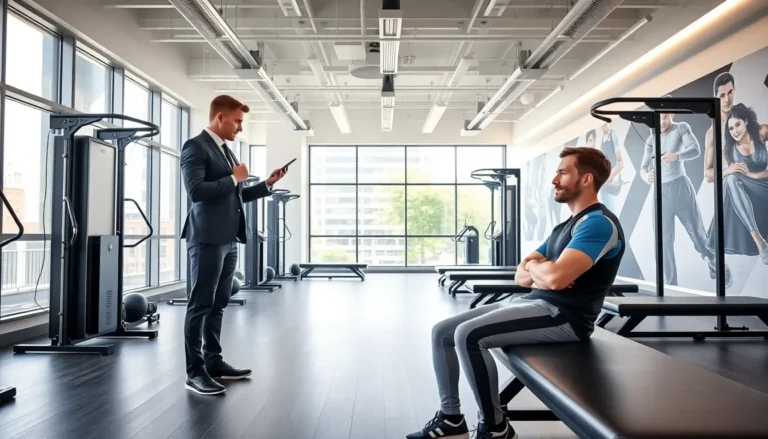In a world where fitness trends come and go faster than you can complete a burpee, mastering fitness sales training is not just a perk, it’s a necessity for anyone in the industry. Picture this: You’re standing in a gym, trying to convince someone to drop their overpriced latte for a gym membership instead. How do you become the expert who’s not just selling, but also empowering? This article aims to untangle the ropes of fitness sales training, offering insights that are as dynamic as the weights in a rack. So lace up those sneakers, and let’s jump into how you can pump up your sales game.
Table of Contents
ToggleUnderstanding the Fitness Sales Landscape

The fitness industry is booming, valued at over $100 billion globally, and it’s only growing. With countless gyms, studios, and personal trainers out there, standing out can seem impossible. Understanding the landscape means recognizing who your competitors are and how they attract customers. The journey starts with identifying target demographics: Are you focusing on fitness novices, seasoned gym-goers, or perhaps a niche market like seniors or athletes? Each segment has unique needs and motivations.
Also, embracing digital transformation is crucial. Online memberships, fitness apps, and virtual training sessions have altered the sales dynamics significantly. Being aware of these trends enables sales professionals to tailor their approach, making it more relevant. Are potential clients browsing social media? If so, your strategy should engage them where they spend their time.
By comprehensively grasping the fitness sales landscape, sales teams can craft targeted pitches and build the right connections, ensuring they’re not just selling a service but a lifestyle.
Key Skills for Successful Fitness Sales Professionals
Sales success in the fitness realm relies on more than just knowing how to sell. Certain skills elevate a fitness sales professional from average to exceptional.
First off, effective communication is crucial. Whether it’s chatting face-to-face or crafting a persuasive email, understanding client needs and articulating solutions is key. People appreciate a personalized touch, so the ability to tailor conversations accordingly can make a significant difference.
Secondly, resilience is essential. The fitness industry is filled with rejection: learning to bounce back and maintain enthusiasm is crucial. It’s not personal: it’s just part of the game.
Besides, possessing a good understanding of fitness itself is invaluable. When a client hears knowledgeable insights about training programs or nutrition, it builds trust. If they know you’re credible, they’re more likely to believe in the services you offer.
Finally, having a mind attuned to data is becoming increasingly important. Understanding metrics such as conversion rates or membership renewals can guide your strategies, helping refine sales tactics.
Developing an Effective Sales Strategy
Crafting a sales strategy within a fitness context isn’t just about hitting quotas: it’s about developing a systematic approach that aligns with clients’ needs. Start by outlining clear goals. What do you want to achieve? Is it more memberships, retaining existing clients, or upselling products and services? Setting specific, measurable targets creates a roadmap for success.
Next, segment your offerings. Rather than presenting a one-size-fits-all package, tailor programs based on fitness goals, weight loss, muscle gain, or rehabilitation. When clients feel a program speaks directly to their aspirations, they’re much more likely to invest.
Incorporating technology is another wise strategy. Use CRM systems to track client interactions, send personalized follow-ups, and automate reminders for re-engagement. Also, consider leveraging social proof. Testimonials and case studies can act as powerful selling tools: people love hearing success stories from others.
Finally, continuously evaluate the strategy’s effectiveness. Are certain programs selling better than others? What feedback are clients providing? Iteration is key in developing a successful strategy.
Building Strong Client Relationships
At the core of successful fitness sales lies the ability to foster genuine relationships with clients. This isn’t merely about making a sale: it’s about creating a community. Start by listening actively during consultations. Understanding pain points and personal fitness goals can help tailor future conversations and offers.
Follow-ups play an essential part in this process, too. Sending a quick ‘check-in’ message or asking for feedback creates an impression of care. Clients are more likely to feel valued when they know their fitness sales professional genuinely cares about their progress.
Also, consider creating a rewards program for continued engagement. Offering discounts or exclusive access to special events not only incentivizes clients to stay but also reinforces loyalty. Also, sharing educational content, like newsletters or social media posts, enhances trust and establishes you as an authority in fitness. Building relationships ensures clients won’t just come and go: they will remain advocates for your services.
Overcoming Common Sales Objections
In sales, encountering objections is a staple of the trade. In the fitness realm, common objections might include concerns about price, time commitment, or satisfaction with previous experiences. Preparing for these objections can significantly enhance a sales professional’s effectiveness.
When faced with price objections, it’s essential to communicate value clearly. Explain how investing in a membership is not just a cost but an investment in health and well-being. Help clients see the long-term benefits.
Time constraints are another common fear. Present flexible training options or customized schedules to ease those concerns. For clients who have had negative experiences before, focus on how your unique offerings and services set you apart from the rest, providing a fresh and uplifting experience.
Role-playing common scenarios with team members can also hone skills in navigating objections, giving sales professionals the confidence to handle these tricky conversations seamlessly.
Ongoing Training and Development for Sales Teams
The fitness industry evolves rapidly, meaning the importance of ongoing training for sales teams cannot be overstated. Regular workshops or online courses can keep staff updated on the latest health trends, sales techniques, and technology. It’s not just about initial training: continuous development is essential for sustained success.
Encouraging teams to attend industry conferences or webinars exposes them to new strategies and networking opportunities. Sharing best practices within the team can also learn from each other.
Creating a culture of feedback fosters an environment where team members feel comfortable sharing insights from their interactions. Regularly reviewing performance metrics and discussing areas for improvement can propel teams to new heights.








